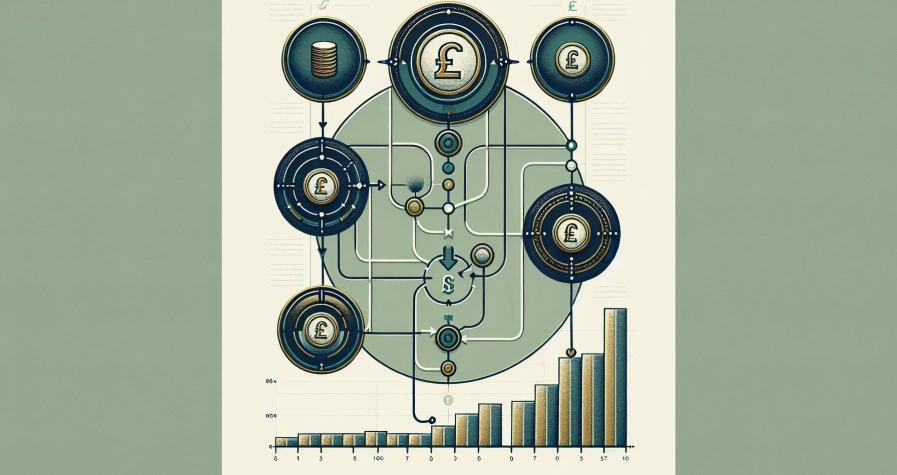Stepping into the cryptocurrency market can feel like entering a foreign land with its own language, and in many ways, it is. For absolute beginners, one of the most intimidating yet essential skills to master is learning how to read crypto charts. These visual representations of price movements may look like a jumble of coloured bars, lines, and numbers at first glance, but they’re actually powerful tools that reveal market sentiment, trends, and opportunities.
Understanding how to read crypto charts isn’t just a nice-to-have skill for traders and investors: it’s fundamental. Whether someone is planning their first Bitcoin purchase or exploring altcoins, chart-reading skills allow them to make informed decisions, identify entry and exit points, and manage risk in one of the most volatile markets on the planet. Without this knowledge, they’re essentially navigating blind, relying on gut feeling or the opinions of strangers online.
This guide breaks down everything an absolute beginner needs to know about reading crypto charts, from the basic components and chart types to recognising patterns and avoiding common pitfalls. By the end, readers will have the foundational knowledge to confidently interpret price movements and take their first steps towards smarter crypto trading.
Key Takeaways
- Learning how to read crypto charts is essential for making informed trading decisions and managing risk in volatile cryptocurrency markets.
- Candlestick charts are the most popular format, displaying open, close, high, and low prices with colour-coded candles that reveal market sentiment at a glance.
- Trading volume confirms price movements—high volume during price changes suggests genuine market interest, whilst low volume often signals weak or unreliable moves.
- Support and resistance levels act as psychological price floors and ceilings where traders expect reversals or breakouts, helping identify strategic entry and exit points.
- Beginners should analyse multiple timeframes to understand the broader trend before fine-tuning trades, avoiding the noise and false signals of very short intervals.
- Mastering chart-reading fundamentals empowers crypto investors to move beyond guesswork and develop disciplined, strategic approaches to navigating the market.
Why Understanding Crypto Charts Matters

Before diving into the mechanics of chart reading, it’s worth asking: why bother? Can’t beginners just buy and hold, or follow tips from social media?
The short answer is that crypto markets move fast, sometimes violently, and charts provide real-time insights that words simply can’t. They illustrate market sentiment at a glance, showing whether buyers or sellers are in control, whether momentum is building or fading, and where price might encounter obstacles.
For traders, charts help spot opportunities that align with their strategy. A swing trader might look for reversal patterns at support levels, whilst a day trader hunts for short-term breakouts. Even long-term investors benefit: analysing historical trends and key levels helps them avoid buying at peaks or panic-selling during temporary dips.
Risk management is another critical reason. Charts allow traders to set stop-loss orders intelligently, identify when a trade isn’t working, and size positions according to volatility. In a market where prices can swing 10% or more in hours, having a visual roadmap isn’t optional, it’s essential.
Eventually, understanding crypto charts empowers beginners to take control of their decisions rather than relying on hype, fear, or external advice. It’s the difference between gambling and strategic investing.
Essential Components of a Crypto Chart
Every crypto chart, regardless of platform or style, shares a few fundamental components. Getting familiar with these basics is the first step towards fluency in chart reading.
Price Axis and Time Axis
At its core, a crypto chart is a graph. The vertical axis (usually on the right) represents the asset’s price, denominated in the base currency, often USD, GBP, or another cryptocurrency like Bitcoin. The higher up the chart, the higher the price.
The horizontal axis runs along the bottom and represents time. Depending on the selected timeframe, each point or bar on the chart might represent one minute, one hour, one day, or even one week. This axis allows traders to see how price has evolved and identify patterns over specific periods.
Together, these axes create a coordinate system where every price level corresponds to a moment in time, forming the backbone of any chart analysis.
Trading Pairs and Market Data
Crypto charts always display a trading pair, two assets being exchanged. For example, BTC/USD shows Bitcoin priced in US dollars, whilst ETH/BTC shows Ethereum’s value relative to Bitcoin. Understanding the pair is crucial because the same cryptocurrency can look very different depending on what it’s measured against.
Beyond price, charts also display market data such as trading volume (the amount of the asset traded in a period) and sometimes order flow or depth. Volume, in particular, is a key indicator of market activity and conviction, high volume during a price move suggests strong interest, whilst low volume hints at weak commitment.
By familiarising themselves with these components, beginners can start to “read” charts as coherent stories rather than random squiggles.
Types of Crypto Charts You’ll Encounter
Not all charts are created equal. Depending on the platform and a trader’s preferences, they’ll encounter several types of charts, each offering different levels of detail.
Line Charts
The simplest type, line charts connect closing prices over a chosen timeframe, forming a continuous line. They’re excellent for getting a quick sense of overall trends and long-term direction without clutter.
But, line charts sacrifice detail. They don’t show opening prices, highs, or lows within each period, which means traders miss out on intraday volatility and potential reversal signals. Line charts are useful for beginners taking their first look at price history, but most move on to more informative formats quickly.
Candlestick Charts
By far the most popular chart type amongst crypto traders, candlestick charts provide a wealth of information at a glance. Each “candle” represents a specific time period and displays four key prices: open, close, high, and low.
The body of the candle shows the range between opening and closing prices, whilst the thin lines, called wicks or shadows, extend to the period’s high and low. Colours indicate direction: green (or white) candles mean the close was higher than the open (bullish), whilst red (or black) candles show the close was lower (bearish).
Candlestick charts convey market sentiment visually. A long green candle suggests strong buying pressure, whilst a red candle with long upper wick might indicate sellers rejected higher prices. This richness of information makes candlestick charts the go-to choice for serious traders.
Bar Charts
Sitting somewhere between line and candlestick charts, bar charts also display open, high, low, and close prices for each period. Each bar consists of a vertical line (high to low) with small horizontal ticks: one on the left for the opening price, one on the right for the closing price.
Bar charts offer similar data to candlesticks but in a less visually intuitive format. They’re less common in crypto trading, though some traditional traders prefer them out of habit. For beginners, candlesticks tend to be easier to interpret.
Understanding Candlesticks in Detail
Given their popularity, it’s worth exploring candlesticks more deeply. Mastering candlestick anatomy and interpretation is a cornerstone skill for any chart reader.
Anatomy of a Candlestick
Each candlestick has two main parts: the body and the wicks (also called shadows).
The body represents the range between the opening and closing prices. A thick, solid body indicates a significant difference between open and close, suggesting strong directional movement. A thin body, sometimes called a doji when open and close are nearly identical, suggests indecision or balance between buyers and sellers.
The wicks extend above and below the body, marking the highest and lowest prices reached during the period. A long upper wick shows that price moved higher but was pushed back down by sellers: a long lower wick indicates price dropped but buyers stepped in to lift it back up.
By examining the size and position of bodies and wicks, traders can infer the tug-of-war between buyers and sellers during that timeframe.
Green vs Red Candles
Colour coding makes candlestick charts instantly readable.
Green (or white) candles signal bullish sentiment. The opening price is at the bottom of the body, and the closing price is at the top, meaning buyers drove the price higher during that period. A long green candle with short wicks suggests sustained buying pressure.
Red (or black) candles indicate bearish sentiment. The opening price is at the top, and the closing price at the bottom, showing sellers dominated. A long red candle hints at strong selling momentum.
When multiple green candles stack up, they form an uptrend: a series of red candles suggests a downtrend. But, individual candles should always be read in context, one red candle in a strong uptrend might just be a pause rather than a reversal.
Learning to read candlestick patterns, from simple bullish engulfing candles to more complex formations like morning stars, takes practice. But even beginners can glean valuable insights by simply observing the colour, size, and wick structure of recent candles.
Reading Trading Volume
Price tells part of the story, but volume completes it. Trading volume, the total amount of an asset traded during a given period, appears as a series of vertical bars at the bottom of most charts.
High volume during a price increase confirms strong buying interest: it suggests the move is genuine and supported by real market participation. Conversely, low volume during a rally raises questions, it might be a weak move that’s easily reversed.
Similarly, high volume during a price drop signals strong selling pressure and conviction, whilst low volume declines might indicate a lack of serious sellers, potentially leading to a bounce.
Volume also helps identify breakouts and breakdowns. When price moves through a key support or resistance level on high volume, it’s more likely the breakout will hold. Low-volume breakouts often fail, trapping traders on the wrong side.
For beginners, a simple rule of thumb is this: strong price moves on strong volume are more trustworthy than moves on weak volume. Volume is the crowd’s voice, listen to it.
Timeframes and How to Choose Them
Charts can display price action over any period, from one-minute intervals to monthly views. Choosing the right timeframe depends on a trader’s goals and strategy.
Shorter timeframes (1-minute, 5-minute, 15-minute) suit day traders and scalpers who seek quick profits from small price movements. These charts are noisy and fast-moving, requiring constant attention and rapid decision-making. Beginners often find them overwhelming and prone to false signals.
Medium timeframes (1-hour, 4-hour, daily) strike a balance. They filter out much of the noise whilst still providing timely signals. Swing traders and position traders often prefer these views, which reveal short- to medium-term trends without demanding round-the-clock monitoring.
Longer timeframes (weekly, monthly) offer the big picture. They’re ideal for long-term investors who want to understand major trends, historical support and resistance zones, and macro cycles. Decisions based on weekly or monthly charts tend to be less reactive and more strategic.
A useful tip for beginners: analyse multiple timeframes. Start with a longer view to understand the overall trend, then zoom into shorter timeframes to fine-tune entry and exit points. This multi-timeframe analysis helps avoid the trap of trading against the prevailing trend.
Basic Chart Patterns to Recognise
Once comfortable with chart components and candlesticks, beginners can start identifying patterns, repeating formations that suggest probable future price movements.
Support and Resistance Levels
These are the most fundamental concepts in chart analysis.
Support is a price level where buying interest is strong enough to prevent further decline, think of it as a floor. When price approaches support, traders expect buyers to step in, potentially causing a bounce.
Resistance is the opposite: a ceiling where selling pressure historically prevents further gains. Price often stalls or reverses at resistance.
These levels aren’t arbitrary. They form where previous buying or selling activity clustered, creating psychological anchors. For example, if Bitcoin repeatedly bounced at £25,000, that level becomes support. If it struggled to break £30,000 multiple times, that’s resistance.
When support breaks, it often becomes new resistance, and vice versa, a concept called role reversal. Recognising these zones helps traders plan entries, exits, and stop-loss placements.
Trends and Trend Lines
A trend is simply the general direction of price movement.
An uptrend features higher highs and higher lows, each peak and trough is above the previous one. Drawing a line connecting the rising lows creates an uptrend line, which acts as dynamic support.
A downtrend shows lower highs and lower lows. Connecting the descending highs creates a downtrend line, acting as resistance.
Trend lines help traders stay on the right side of the market. Trading with the trend, buying in uptrends, selling or shorting in downtrends, is generally safer than fighting it.
Other common patterns include double tops and bottoms (reversal signals after strong trends), and triangles (ascending, descending, or symmetrical), which indicate consolidation before a breakout. Learning to spot these patterns takes practice, but they’re powerful tools for anticipating price moves.
Common Beginner Mistakes to Avoid
Even with solid chart-reading knowledge, beginners often stumble into predictable traps. Awareness is half the battle.
Relying on one chart type alone: Some traders fixate on candlesticks and ignore volume or timeframe context. Charts should be read holistically, combining price action, volume, and multiple timeframes yields better insights.
Ignoring market news and sentiment: Charts reflect price history, but they don’t predict black-swan events or major news. A perfectly bullish chart can collapse if a major exchange is hacked or regulators announce a crackdown. Always complement technical analysis with awareness of broader market conditions.
Overtrading or misusing short timeframes: The temptation to trade every small wiggle on a 5-minute chart is strong, especially for beginners. But short timeframes magnify noise and transaction costs, often leading to losses. It’s wiser to wait for high-probability setups on longer timeframes.
Ignoring risk management: No chart pattern is 100% reliable. Beginners sometimes forget to set stop-losses or risk too much capital on a single trade, leading to painful losses. Charts guide decisions, but disciplined risk management protects capital.
Avoiding these pitfalls helps beginners trade smarter and build confidence without costly mistakes.
Conclusion
Learning how to read crypto charts might seem daunting at first, but it’s a skill that opens doors. With a grasp of chart components, candlestick anatomy, volume analysis, and basic patterns, absolute beginners can move beyond guesswork and start making informed trading and investment decisions.
The journey doesn’t end here. Chart reading is as much art as science, and proficiency comes with practice, observation, and a willingness to learn from mistakes. As beginners spend time studying charts, they’ll develop an intuition for market rhythms and price behaviour that no tutorial can fully teach.
The key is to start simple, master the fundamentals before diving into complex indicators or advanced strategies. Use demo accounts or small positions to test chart-based decisions without risking significant capital. And remember: even experienced traders never stop learning.
By building chart-reading skills now, beginners lay the foundation for a more confident, strategic approach to navigating the wild, rewarding world of cryptocurrency markets.
Frequently Asked Questions
What are the most important components of a crypto chart for beginners?
Essential components include the price axis (showing asset value), time axis (displaying time periods), trading pairs (like BTC/USD), and volume bars. Together, these elements create a visual coordinate system that reveals how cryptocurrency prices evolve over time and market activity levels.
How do candlestick charts help you read crypto market sentiment?
Candlestick charts display open, close, high, and low prices for each period. Green candles indicate bullish sentiment with prices closing higher, whilst red candles show bearish sentiment. The body size and wick length reveal the strength of buying or selling pressure during that timeframe.
What timeframe should I use when reading crypto charts as a beginner?
Beginners should start with medium timeframes like 1-hour, 4-hour, or daily charts, which filter out noise whilst providing clear signals. Analyse multiple timeframes—start with longer views for overall trends, then zoom into shorter periods to refine entry and exit points.
Why is trading volume important when analysing cryptocurrency charts?
Trading volume confirms the strength of price movements. High volume during price increases signals genuine buying interest, whilst low volume suggests weak moves that may reverse. Volume helps identify trustworthy breakouts and distinguishes real trends from false signals in volatile crypto markets.
Can you trade cryptocurrency successfully without learning technical analysis?
Whilst possible to buy and hold without chart analysis, trading without understanding technical indicators significantly increases risk. Charts provide real-time market insights, help identify entry and exit points, enable proper risk management, and prevent emotional decisions driven by hype or fear.
What is the difference between support and resistance levels in crypto trading?
Support is a price level where buying interest prevents further decline, acting as a floor. Resistance is where selling pressure stops upward movement, functioning as a ceiling. These levels form at prices where significant trading activity occurred, creating psychological anchors for future price behaviour.









